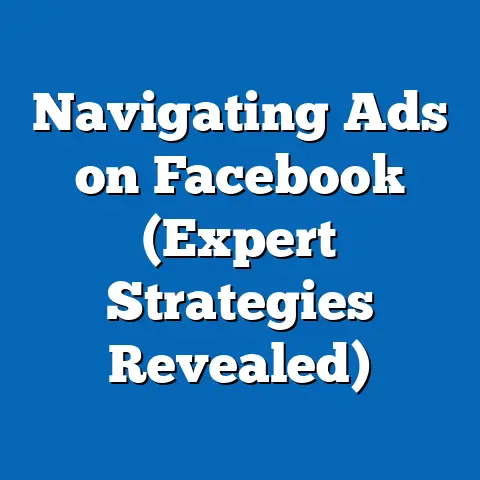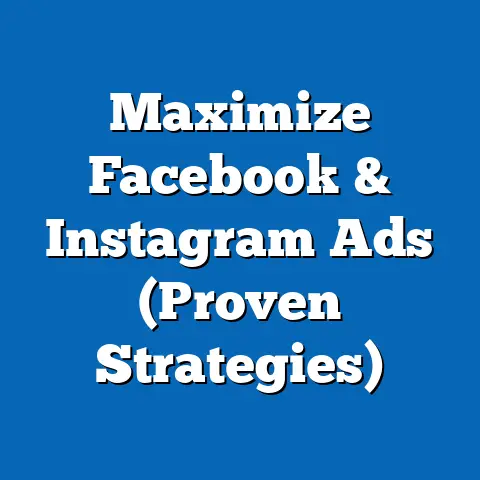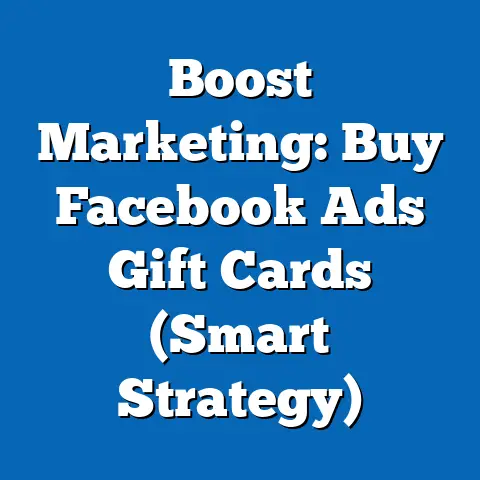Unlock Facebook Ads Demographics (Insights Unveiled)
Facebook advertising. It’s a powerhouse. I’ve seen firsthand how it can catapult a small startup into a recognized brand, or breathe new life into a struggling business. But here’s the thing: simply throwing money at Facebook ads isn’t enough. It’s like casting a wide net into the ocean and hoping to catch something valuable. You might get lucky, but the odds are stacked against you.
The real magic happens when you understand your audience, and that’s where the power of demographics comes into play. Think of demographics as the key to unlocking a treasure chest of potential customers. It’s about understanding who they are, where they are, what they like, and what makes them tick.
I remember working with a local bakery that was struggling to attract new customers. They were running generic ads, targeting everyone in a 20-mile radius. The results were… underwhelming. After diving into their customer data and using Facebook’s demographic tools, we discovered that their most loyal customers were women aged 25-45 who were interested in baking, healthy eating, and local events.
We completely revamped their ad strategy, creating targeted ads that showcased their organic ingredients and highlighted their participation in local farmers’ markets. The result? A 40% increase in foot traffic and a significant boost in online orders within just a few weeks.
That’s the power of understanding your demographics. In this article, I’ll guide you through the ins and outs of Facebook ads demographics, showing you how to analyze your audience, craft targeted ads, and ultimately, unlock the full potential of your Facebook advertising efforts. So, buckle up, because we’re about to dive deep into the world of data-driven marketing!
1. The Importance of Demographics in Facebook Advertising
Demographics, in the context of Facebook advertising, are the specific characteristics of a population or audience that you can use to target your ads. They’re the building blocks of your ideal customer profile. Forget the days of spray-and-pray advertising; demographic targeting allows you to laser-focus your message on the people most likely to be interested in your product or service.
Key Demographic Factors Available on Facebook
Facebook offers a wealth of demographic data, allowing you to target your ads with incredible precision. Here are some of the key factors you can leverage:
- Age: Target specific age ranges to ensure your ads resonate with the right generation.
- Gender: Tailor your messaging to appeal to either men, women, or both.
- Location: Reach customers in specific cities, regions, or countries.
- Interests: Target people based on their hobbies, passions, and interests, as indicated by their Facebook activity.
- Behaviors: Target users based on their online behavior, such as purchase history, device usage, and travel habits.
- Education: Target people based on their education level, from high school to postgraduate degrees.
- Relationship Status: Target people based on their relationship status, such as single, married, or in a relationship.
- Job Title: Target people based on their job title or industry.
- Language: Target people based on the language they speak.
- Parents: Target parents based on the age of their children.
Why Understanding Demographics is Crucial
Understanding these demographics is absolutely crucial for crafting effective advertising campaigns for a few key reasons:
- Improved Targeting: Demographic insights allow you to create highly targeted audiences, ensuring that your ads are seen by the people most likely to convert.
- Increased ROI: By targeting the right audience, you can increase your return on investment (ROI) by reducing wasted ad spend on irrelevant users.
- Enhanced Ad Relevance: When your ads are relevant to your audience, they’re more likely to engage with them, leading to higher click-through rates and conversion rates.
- Personalized Messaging: Demographic data allows you to tailor your ad copy and visuals to resonate with specific segments of your audience, creating a more personalized and impactful experience.
- Reduced Costs: By targeting a more specific audience, you can often reduce your overall advertising costs, as you’re not wasting money on impressions from people who are unlikely to convert.
Data-Driven Success: Real-World Examples
Let’s look at some examples to illustrate the impact of demographic targeting:
- A fitness studio targeting young adults (18-25) with ads featuring high-energy workouts and trendy music saw a 60% increase in new memberships. They understood their target demographic’s interest in fitness trends and leveraged that knowledge to create compelling ads.
- A luxury skincare brand targeting women aged 35-55 with ads showcasing anti-aging products and testimonials saw a 45% increase in online sales. They knew their target demographic was concerned about aging and crafted their messaging accordingly.
- A travel agency targeting families with young children with ads featuring family-friendly resorts and activities saw a 50% increase in booking inquiries. They understood the needs and interests of their target demographic and tailored their ads to match.
Key Takeaway: Demographic targeting isn’t just a nice-to-have; it’s a must-have for any successful Facebook advertising campaign. By understanding your audience, you can create more relevant, engaging, and effective ads that drive real results. Next, let’s dive into the Facebook Ads Manager.
2. Navigating Facebook Ads Manager
Facebook Ads Manager is the central hub for creating, managing, and analyzing your Facebook advertising campaigns. It can seem a little overwhelming at first, but I promise, once you get the hang of it, it’s a powerful tool.
Step-by-Step Guide to Accessing and Utilizing Ads Manager
Here’s a step-by-step guide to navigating Facebook Ads Manager:
-
Accessing Ads Manager:
- Log in to your Facebook account.
- Click on the downward-facing arrow in the top right corner of the screen.
- Select “Manage Ads” from the dropdown menu.
- Alternatively, you can go directly to https://www.facebook.com/adsmanager
-
Understanding the Interface:
- The Ads Manager interface is divided into three main sections:
- Campaigns: This is where you create and manage your overall advertising campaigns.
- Ad Sets: This is where you define your target audience, budget, and ad schedule.
- Ads: This is where you create and manage your individual ads.
- The Ads Manager interface is divided into three main sections:
-
Creating a New Campaign:
- Click on the “+ Create” button in the top left corner of the screen.
- Choose your campaign objective (e.g., awareness, traffic, engagement, leads, sales).
- Give your campaign a name and click “Continue.”
-
Setting Up Your Ad Set:
- Define your target audience by selecting demographic characteristics, interests, and behaviors.
- Set your budget and schedule for the ad set.
- Choose your ad placements (e.g., Facebook feed, Instagram feed, Audience Network).
-
Creating Your Ad:
- Choose your ad format (e.g., single image, video, carousel, collection).
- Upload your creative assets (images or videos).
- Write your ad copy and add a call to action.
- Preview your ad to see how it will look on different placements.
Accessing Ads Manager:
- Log in to your Facebook account.
- Click on the downward-facing arrow in the top right corner of the screen.
- Select “Manage Ads” from the dropdown menu.
- Alternatively, you can go directly to https://www.facebook.com/adsmanager
Understanding the Interface:
- The Ads Manager interface is divided into three main sections:
- Campaigns: This is where you create and manage your overall advertising campaigns.
- Ad Sets: This is where you define your target audience, budget, and ad schedule.
- Ads: This is where you create and manage your individual ads.
- Campaigns: This is where you create and manage your overall advertising campaigns.
- Ad Sets: This is where you define your target audience, budget, and ad schedule.
- Ads: This is where you create and manage your individual ads.
Creating a New Campaign:
- Click on the “+ Create” button in the top left corner of the screen.
- Choose your campaign objective (e.g., awareness, traffic, engagement, leads, sales).
- Give your campaign a name and click “Continue.”
Setting Up Your Ad Set:
- Define your target audience by selecting demographic characteristics, interests, and behaviors.
- Set your budget and schedule for the ad set.
- Choose your ad placements (e.g., Facebook feed, Instagram feed, Audience Network).
Creating Your Ad:
- Choose your ad format (e.g., single image, video, carousel, collection).
- Upload your creative assets (images or videos).
- Write your ad copy and add a call to action.
- Preview your ad to see how it will look on different placements.
Tools and Features for Demographic Analysis
Ads Manager offers a range of tools and features that can help you analyze demographics and optimize your campaigns:
- Audience Insights: This tool provides detailed demographic data about your target audience, including their age, gender, location, interests, and behaviors. (We’ll delve deeper into this in the next section).
- Ad Performance Metrics: Ads Manager tracks a wide range of metrics, such as impressions, reach, clicks, click-through rate (CTR), conversion rate, and cost per acquisition (CPA). These metrics can help you understand how your ads are performing with different demographic segments.
- A/B Testing: Ads Manager allows you to create multiple versions of your ads and test them against each other to see which performs best with different demographics.
- Custom Audiences: You can create custom audiences based on your existing customer data, such as email lists or website visitors. This allows you to target your ads to people who are already familiar with your brand.
- Lookalike Audiences: You can create lookalike audiences based on your custom audiences. This allows you to target people who share similar characteristics with your existing customers.
Ads Manager: User-Friendly and Accessible
Facebook has invested heavily in making Ads Manager user-friendly and accessible, even for beginners. The interface is intuitive, and there are plenty of helpful resources available, including:
- Facebook Ads Help Center: This comprehensive resource provides answers to common questions and troubleshooting tips.
- Facebook Blueprint: This online learning platform offers courses on a variety of Facebook advertising topics.
- Facebook Business Community: This online forum allows you to connect with other advertisers and ask questions.
Key Takeaway: Facebook Ads Manager is your command center for all things advertising on Facebook. By understanding the interface and utilizing the available tools and features, you can effectively analyze demographics, create targeted ads, and optimize your campaigns for maximum ROI. Now, let’s explore the power of Audience Insights.
3. Analyzing Audience Insights
Audience Insights is a powerful tool within Facebook Ads Manager that allows you to gather detailed demographic data about potential customers. It’s like having a virtual focus group at your fingertips.
Gathering Demographic Data with Audience Insights
Here’s how to use Audience Insights to gather demographic data:
-
Accessing Audience Insights:
- In Ads Manager, click on the “Tools” menu.
- Select “Audience Insights” from the dropdown menu.
-
Choosing Your Audience:
- You can choose to analyze either:
- Everyone on Facebook: This allows you to get a broad overview of the demographics of Facebook users.
- People connected to your Page: This allows you to analyze the demographics of your existing fans and followers.
- Custom Audience: This allows you to analyze the demographics of a specific custom audience that you’ve created.
- You can choose to analyze either:
-
Exploring Demographic Data:
- Once you’ve chosen your audience, Audience Insights will display a wealth of demographic data, including:
- Age and Gender: This shows the distribution of age and gender within your audience.
- Location: This shows the geographic locations of your audience.
- Interests: This shows the top interests of your audience, based on their Facebook activity.
- Page Likes: This shows the pages that your audience likes, which can provide insights into their interests and preferences.
- Education Level: This shows the education level of your audience.
- Relationship Status: This shows the relationship status of your audience.
- Job Titles: This shows the job titles of your audience.
- Once you’ve chosen your audience, Audience Insights will display a wealth of demographic data, including:
Accessing Audience Insights:
- In Ads Manager, click on the “Tools” menu.
- Select “Audience Insights” from the dropdown menu.
Choosing Your Audience:
- You can choose to analyze either:
- Everyone on Facebook: This allows you to get a broad overview of the demographics of Facebook users.
- People connected to your Page: This allows you to analyze the demographics of your existing fans and followers.
- Custom Audience: This allows you to analyze the demographics of a specific custom audience that you’ve created.
- Everyone on Facebook: This allows you to get a broad overview of the demographics of Facebook users.
- People connected to your Page: This allows you to analyze the demographics of your existing fans and followers.
- Custom Audience: This allows you to analyze the demographics of a specific custom audience that you’ve created.
Exploring Demographic Data:
- Once you’ve chosen your audience, Audience Insights will display a wealth of demographic data, including:
- Age and Gender: This shows the distribution of age and gender within your audience.
- Location: This shows the geographic locations of your audience.
- Interests: This shows the top interests of your audience, based on their Facebook activity.
- Page Likes: This shows the pages that your audience likes, which can provide insights into their interests and preferences.
- Education Level: This shows the education level of your audience.
- Relationship Status: This shows the relationship status of your audience.
- Job Titles: This shows the job titles of your audience.
- Age and Gender: This shows the distribution of age and gender within your audience.
- Location: This shows the geographic locations of your audience.
- Interests: This shows the top interests of your audience, based on their Facebook activity.
- Page Likes: This shows the pages that your audience likes, which can provide insights into their interests and preferences.
- Education Level: This shows the education level of your audience.
- Relationship Status: This shows the relationship status of your audience.
- Job Titles: This shows the job titles of your audience.
Interpreting the Data Presented in Audience Insights
Interpreting the data presented in Audience Insights is crucial for making informed decisions about your advertising strategy. Here are some tips:
- Look for Patterns: Identify common themes and patterns in the data. For example, are the majority of your potential customers women aged 25-34 who are interested in fashion and beauty?
- Compare to Your Existing Customer Base: Compare the demographics of your potential customers to the demographics of your existing customers. Are there any significant differences?
- Identify New Opportunities: Use Audience Insights to identify new potential customer segments that you may not have considered before.
- Use the Data to Refine Your Targeting: Use the insights you gain from Audience Insights to refine your targeting in Ads Manager, ensuring that your ads are seen by the people most likely to convert.
Adjusting Your Ad Strategy Based on Insights
Let’s say you’re running ads for a new line of organic baby food. After analyzing Audience Insights, you discover that your target audience is primarily women aged 25-34 who are interested in parenting, healthy eating, and organic products.
Based on these insights, you can adjust your ad strategy in the following ways:
- Target your ads specifically to women aged 25-34.
- Use ad copy that emphasizes the organic and healthy ingredients in your baby food.
- Showcase images of happy, healthy babies.
- Target your ads to users who are interested in parenting, healthy eating, and organic products.
- Run your ads on Facebook and Instagram, as these platforms are popular with your target demographic.
Continuous Monitoring and Adjustment
It’s important to remember that demographics are not static. They can change over time, as people’s interests and behaviors evolve. Therefore, it’s crucial to continuously monitor Audience Insights and adjust your ad strategy accordingly.
I recommend checking Audience Insights at least once a month to see if there have been any significant changes in your target audience’s demographics. You can also use A/B testing to experiment with different targeting options and see which performs best.
Key Takeaway: Audience Insights is your secret weapon for understanding your potential customers. By analyzing the data presented in this tool, you can gain valuable insights into their demographics, interests, and behaviors, allowing you to create more targeted and effective advertising campaigns.
4. Crafting Targeted Ads Based on Demographics
Now that you understand the importance of demographics and how to analyze them using Audience Insights, let’s talk about how to craft targeted ads that resonate with specific demographic segments.
Creating Ads That Resonate
The key to crafting targeted ads is to understand the needs, interests, and pain points of your target demographic. What are they looking for? What problems are they trying to solve? What motivates them?
Once you understand your target demographic, you can create ads that speak directly to them. This involves:
- Writing Compelling Ad Copy: Your ad copy should be clear, concise, and relevant to your target demographic. Use language that they understand and relate to. Highlight the benefits of your product or service and how it can solve their problems.
- Selecting Visuals That Appeal: Choose images or videos that are visually appealing to your target demographic. Use images that are representative of your target demographic.
- Using a Strong Call to Action: Your call to action should be clear and concise. Tell people exactly what you want them to do (e.g., “Shop Now,” “Learn More,” “Sign Up”).
Tips for Writing Compelling Ad Copy
Here are some tips for writing compelling ad copy that resonates with different demographics:
- Use Different Language for Different Age Groups: Younger audiences may respond better to informal language and slang, while older audiences may prefer more formal language.
- Address Different Needs for Different Genders: Tailor your messaging to address the specific needs and interests of men and women.
- Highlight Different Benefits for Different Interests: If you’re targeting users based on their interests, highlight the benefits of your product or service that are most relevant to those interests.
- Use Location-Specific Language: If you’re targeting users in a specific location, use language that is relevant to that location (e.g., local slang, references to local landmarks).
Examples of Successful Ad Campaigns
Let’s look at some examples of successful ad campaigns that targeted specific demographics effectively:
- A clothing brand targeting college students with ads featuring trendy, affordable clothing and student discounts. They understood the needs and interests of their target demographic and tailored their ads accordingly.
- A financial services company targeting young professionals with ads featuring investment advice and retirement planning tools. They knew their target demographic was concerned about their financial future and crafted their messaging accordingly.
- A travel agency targeting retirees with ads featuring luxury cruises and exotic destinations. They understood the needs and interests of their target demographic and tailored their ads to match.
The Balance Between Broad and Niche Targeting
Finding the right balance between broad targeting and niche targeting is crucial for maximizing your ROI.
- Broad Targeting: Broad targeting involves targeting a large audience with general interests. This can be effective for building brand awareness and reaching a large number of people.
- Niche Targeting: Niche targeting involves targeting a smaller, more specific audience with very specific interests. This can be effective for driving conversions and generating leads.
The best approach depends on your specific goals and budget. If you’re just starting out, you may want to start with broad targeting to build brand awareness. As you gather more data and learn more about your audience, you can gradually refine your targeting to become more niche.
I’ve found that a combination of both broad and niche targeting often works best. You can use broad targeting to reach a large audience and then use niche targeting to retarget users who have shown interest in your brand.
Key Takeaway: Crafting targeted ads is all about understanding your audience and creating ads that speak directly to their needs, interests, and pain points. By writing compelling ad copy, selecting visuals that appeal, and using a strong call to action, you can create ads that resonate with specific demographic segments and drive real results.
5. Case Studies of Successful Demographic Targeting
To further illustrate the power of demographic targeting, let’s examine a couple of case studies of brands that have successfully utilized Facebook ads demographics to drive conversions.
Case Study 1: A Local Coffee Shop
Business: A local coffee shop looking to increase foot traffic and build brand awareness.
Challenge: The coffee shop was struggling to attract new customers and was relying primarily on word-of-mouth marketing.
Strategy:
- Demographic Targeting: The coffee shop targeted users within a 5-mile radius who were interested in coffee, local businesses, and breakfast/brunch. They also targeted users who had recently checked into nearby coffee shops.
- Ad Copy: The ad copy highlighted the coffee shop’s locally sourced beans, delicious pastries, and cozy atmosphere.
- Visuals: The ads featured high-quality photos of the coffee shop’s interior, as well as close-ups of their coffee and pastries.
- Call to Action: The ads included a “Get Directions” button, making it easy for users to find the coffee shop.
Results:
- A 30% increase in foot traffic within the first month.
- A 20% increase in online orders.
- A significant increase in brand awareness within the local community.
Lessons Learned:
- Local businesses can use demographic targeting to reach potential customers in their immediate area.
- Highlighting unique selling points, such as locally sourced ingredients or a cozy atmosphere, can attract customers.
- Using a clear call to action, such as “Get Directions,” can make it easy for users to take the desired action.
Case Study 2: An Online Jewelry Retailer
Business: An online jewelry retailer looking to increase sales of their new line of minimalist jewelry.
Challenge: The retailer was struggling to reach their target audience and was relying primarily on generic advertising.
Strategy:
- Demographic Targeting: The retailer targeted women aged 25-44 who were interested in fashion, jewelry, and minimalist design. They also targeted users who had recently visited the retailer’s website.
- Ad Copy: The ad copy highlighted the jewelry’s minimalist design, high-quality materials, and affordable price point.
- Visuals: The ads featured stylish photos of the jewelry being worn by models.
- Call to Action: The ads included a “Shop Now” button, making it easy for users to purchase the jewelry.
Results:
- A 40% increase in online sales of the minimalist jewelry line.
- A 25% increase in website traffic.
- A significant increase in brand awareness among the target audience.
Lessons Learned:
- Online retailers can use demographic targeting to reach potential customers who are interested in their specific products.
- Highlighting key features, such as minimalist design or high-quality materials, can attract customers.
- Using a clear call to action, such as “Shop Now,” can make it easy for users to make a purchase.
Key Takeaway: These case studies demonstrate the power of demographic targeting to drive real results for businesses of all sizes. By understanding your audience and crafting targeted ads that resonate with them, you can significantly increase your ROI and achieve your advertising goals.
Conclusion
So, there you have it. We’ve journeyed through the world of Facebook ads demographics, from understanding why they matter to analyzing them in Audience Insights and crafting targeted ads that convert.
I hope I’ve made it clear that effectively leveraging Facebook ads demographics isn’t just about knowing who your audience is; it’s about understanding their needs, desires, and motivations. It’s about speaking their language and showing them that you understand them.
Remember that bakery I mentioned at the beginning? Their success wasn’t just about targeting the right age group or location; it was about understanding their audience’s passion for baking, their desire for healthy options, and their connection to the local community.
By taking the time to understand your audience, you can create advertising campaigns that are not only more effective but also more meaningful. You can build stronger customer relationships, foster brand loyalty, and ultimately, achieve your business goals.
So, I encourage you to take what you’ve learned in this article and put it into action. Dive into Facebook Ads Manager, explore Audience Insights, and start crafting targeted ads that resonate with your audience.
The potential is there, waiting to be unlocked. Don’t just cast a wide net; use the power of demographics to target your efforts and reel in the results you’ve been dreaming of. The transformation of your business could be just one well-targeted ad away. Go out there and make it happen!






